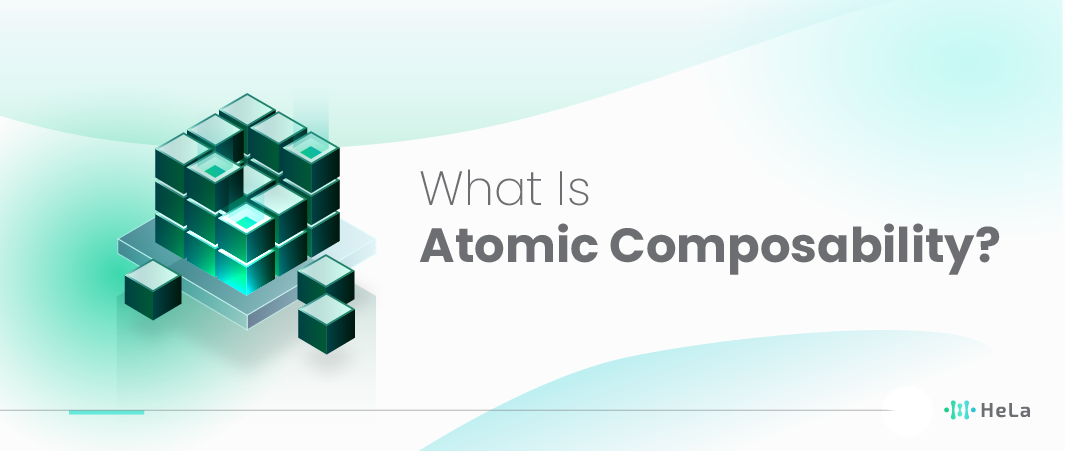In the rapidly evolving world of blockchain technology, a new concept has emerged, reshaping how developers and users perceive and interact with decentralized platforms. This concept, known as atomic composability, stands at the forefront of innovation, promising to streamline and enhance the functionality of blockchain ecosystems. But what exactly does atomic composability entail, and why is it garnering so much attention? At its core, atomic composability refers to the ability of different components or operations within a blockchain to interact and execute seamlessly in a single, indivisible transaction. This foundational principle is not just a technical jargon but a revolutionary approach that could potentially unlock unprecedented levels of interoperability and efficiency in blockchain networks.
Diving deeper, atomic composability allows for the creation of complex, multi-step processes that can operate without the risk of failure partway through. Imagine a scenario where various financial transactions, smart contract executions, and data transfers happen concurrently, without the fear of one component failing and derailing the entire operation. This level of reliability and efficiency is what makes atomic composability a game-changer in the blockchain space. By ensuring that either all operations within a transaction are completed successfully or none at all, it provides a safety net that is crucial for the trust and security inherent in blockchain technology.
The implications of atomic composability extend beyond technical efficiency; they touch upon user experience, developer creativity, and the overall potential of blockchain applications. As we delve into this concept, we’ll explore its impact, how it’s being utilized, and the future possibilities it holds. From fostering seamless interactions between different blockchain protocols to enabling complex financial instruments and applications, atomic composability is a key to unlocking the next generation of blockchain innovation.
What Is Atomic Composability?
Atomic composability is a fundamental concept in the realm of blockchain technology, emphasizing the importance of executing multiple operations as a single, indivisible transaction. In essence, this principle ensures that within a blockchain transaction, a group of actions are so closely linked that they must all be completed successfully together, or none at all. This binary outcome—complete success or total failure—safeguards the consistency and integrity of the blockchain ecosystem, making it especially valuable for applications that demand a high degree of trust and dependability.
The concept is akin to atomic transactions in database systems, where “atomic” refers to the smallest unit of work that cannot be broken down further. In blockchain, atomic composability allows developers to create complex, interdependent interactions within a single transaction. This could include, for example, swapping tokens, lending assets, and paying for a service all within one transaction. If any part of this transaction fails, the entire operation is reverted, ensuring that the blockchain remains in a consistent state.
Atomic composability is particularly important in decentralized finance (DeFi) applications, where it enables sophisticated financial instruments and mechanisms to operate seamlessly and securely. By ensuring that all parts of a transaction are executed together, atomic composability mitigates risks such as partial execution or the manipulation of transaction order, which could lead to vulnerabilities like front running or arbitrage exploits.
Moreover, atomic composability fosters innovation and complex ecosystem development within the blockchain space. It allows for the creation of new financial products and services that can interact with each other in predictable and secure ways, thereby expanding the potential use cases for blockchain technology. This characteristic is crucial for the scalability and versatility of decentralized applications (dApps), making atomic composability a cornerstone of blockchain development and deployment.
Enabling Seamless Interactions Across Blockchains
Atomic composability is a groundbreaking concept in the blockchain realm, significantly enhancing the interoperability and synergy between disparate blockchain networks. This technology enables different blockchain platforms and protocols to interact and operate together seamlessly within a single transaction framework. At its core, atomic composability allows for the execution of complex operations that involve multiple steps across different blockchains in a way that either all steps are completed successfully or none at all, ensuring consistency and reliability.
The primary benefit of this approach is the elimination of silos within the blockchain ecosystem. Traditionally, each blockchain operates in isolation, with limited ability for cross-chain interaction. This isolation not only hinders the flow of assets and information between different blockchains but also limits the potential for innovative applications that require capabilities from multiple platforms. Atomic composability tackles this challenge head-on by enabling a fluid exchange of assets, data, and functionality across diverse blockchain environments without the need for intermediaries or complex bridging protocols.
Also Read: 10 Top Smart Contract Blockchains to Know in 2024
For developers and users, this translates into a more unified and accessible blockchain ecosystem. Projects can leverage the strengths of multiple blockchains, such as Ethereum’s smart contract capabilities and Bitcoin’s secure network, within a single, coherent operation. This not only enhances the efficiency and scalability of decentralized applications (DApps) but also opens up new possibilities for cross-chain applications, such as decentralized finance (DeFi) protocols that can operate across multiple blockchains, enhancing liquidity and user access.
Moreover, atomic composability contributes to a more robust and resilient blockchain infrastructure. By facilitating direct interactions between blockchains, it reduces the reliance on centralized exchanges and other third-party services, which can be points of vulnerability. This decentralized approach enhances security and reduces the risk of hacks, fraud, and other malicious activities.
Atomic composability represents a significant leap forward in achieving a truly interconnected blockchain ecosystem. By enabling seamless interactions across blockchains, it paves the way for a new era of innovation and collaboration in the blockchain space, with the potential to significantly impact various sectors, including finance, supply chain, and beyond.
Boosting Developer Creativity and Innovation

Atomic composability in the context of blockchain technology refers to the ability to execute multiple operations in a single transaction, ensuring that either all operations are completed successfully or none at all. This characteristic is fundamental to creating a reliable and secure environment for developers working on blockchain platforms.
By leveraging atomic composability, developers gain the confidence to experiment and innovate, knowing that their complex operations will be executed reliably. This assurance is crucial in a domain where the cost of failure can be high, both in terms of financial implications and user trust. With the safety net provided by atomic composability, developers are more inclined to explore novel ideas and push the technological boundaries further.
The impact of this innovation-friendly environment extends beyond the blockchain sphere. As developers create new applications and services that take advantage of the unique properties of blockchain technology—such as transparency, security, and decentralization—industries ranging from finance to supply chain management stand to be revolutionized. For instance, in finance, we could see the emergence of more sophisticated decentralized finance (DeFi) platforms that offer complex financial instruments with unprecedented security and efficiency. In supply chain management, blockchain could enable more transparent and tamper-proof tracking of goods, from production to delivery.
Moreover, atomic composability fosters a culture of collaboration among developers. Since operations can be combined seamlessly, there’s a greater incentive for developers to build on each other’s work, leading to a cumulative effect in innovation. This collaborative approach accelerates the development of new solutions and the evolution of blockchain technology as a whole.
In summary, atomic composability is not just a technical feature; it’s a catalyst for developer creativity and innovation. By providing a reliable and flexible foundation for executing complex operations, it encourages developers to explore new possibilities and paves the way for groundbreaking applications that could transform a wide range of industries.
Simplifying Complex Transactions

Atomic composability is a key concept in the blockchain and DeFi (Decentralized Finance) ecosystems, providing a robust framework for executing complex transactions. This concept is pivotal for transactions that require interactions across various smart contracts or involve multiple assets. Here’s how it simplifies and secures complex transactions:
Atomic Composability Definition
- Atomicity: In computer science, atomicity refers to operations that are either completed fully or not executed at all. This principle ensures that if any part of the transaction fails, the entire operation is rolled back, preventing partial updates or actions that could lead to errors or vulnerabilities.
- Composability: This refers to the ability to combine different components or systems into a single, more complex system. In the context of blockchain, it means that smart contracts can interact with each other in a seamless and integrated manner.
Benefits of Atomic Composability
- Streamlined Processes: By enabling multiple steps and interactions to be executed in a single transaction, atomic composability streamlines the workflow. This integration allows for more complex financial operations to be conducted without the need for multiple transactions or manual coordination between different contracts.
- Security and Reliability: The atomic nature of these transactions ensures that either all operations within a transaction are successfully completed or none at all. This all-or-nothing approach significantly reduces the risk of errors or security vulnerabilities that could arise from partially completed transactions.
- Enhanced User Confidence: Users can engage in sophisticated financial activities with greater confidence. Knowing that their transactions are secured by atomic composability means there’s a lower risk of losing funds due to failed transactions or exploits.
- Efficiency and Cost-Effectiveness: Consolidating multiple operations into a single transaction can also reduce the overall transaction fees and execution time, making complex transactions more accessible and cost-effective for users.
Use Cases
- Decentralized Exchanges (DEXs): Atomic swaps allow for the exchange of one cryptocurrency for another without the need for a trusted third party, reducing counterparty risk.
- Financial Derivatives and Loans: Complex financial instruments, like loans or derivatives contracts, can be executed in a single transaction, ensuring all conditions are met before execution.
- Cross-Chain Operations: Facilitates operations across different blockchain platforms, allowing assets to move seamlessly between chains without the risk of one part of the transaction failing.
Atomic composability is a transformative feature in the blockchain space, enabling a level of transactional complexity and security previously unattainable. As the DeFi ecosystem continues to evolve, the importance and utility of atomic composability are likely to grow, fostering innovation and expanding the possibilities for decentralized finance.
Expanding the Horizons of Decentralized Finance (DeFi)

The concept of atomic composability in decentralized finance (DeFi) is a revolutionary advancement that could significantly transform how financial products and services are offered and consumed on blockchain networks. At its core, atomic composability refers to the capability of different blockchain applications or protocols to interact with each other seamlessly and instantaneously, without the need for intermediaries. This interoperability is achieved through the execution of atomic transactions, which are indivisible and either complete successfully in their entirety or not at all, ensuring a high degree of security and reliability.
In the context of DeFi, atomic composability opens up a myriad of possibilities for creating more sophisticated and flexible financial instruments. It allows for the combination of various financial services like lending, borrowing, trading, and insurance in a single transaction across different blockchain platforms. This not only streamlines the user experience by making transactions more efficient but also broadens the scope of financial products available to users.
One of the key benefits of atomic composability in DeFi is the enhancement of liquidity. By enabling cross-chain interactions, assets can flow more freely across different DeFi ecosystems, reducing the fragmentation of liquidity pools. This can lead to better price discovery, reduced slippage in trading, and more capital efficiency for both users and protocols.
Also Read: Tendermint: The Consensus Engine Powering Next-Gen Blockchains
Moreover, atomic composability fosters innovation by allowing developers to build on existing protocols and services, creating complex, multi-step financial operations that were not possible before. This “Lego block” approach to financial product development encourages the creation of novel investment strategies and tools, further enriching the DeFi ecosystem.
However, the realization of atomic composability’s full potential in DeFi comes with challenges. It requires robust cross-chain communication protocols and standards for interoperability, as well as advanced security measures to prevent exploits in a more interconnected ecosystem. Despite these hurdles, the ongoing development and adoption of atomic composability technology signal a promising future for DeFi, where users can access a global, interoperable, and highly flexible financial system.
Conclusion
Atomic composability represents a pivotal advancement in the realm of blockchain technology. By enabling seamless and reliable interactions between disparate components and ecosystems, it lays the groundwork for a more integrated, innovative, and efficient blockchain landscape. The implications of this technology extend far beyond technical enhancements; they signify a leap towards a future where blockchain applications can be as complex and interconnected as the needs they aim to serve.
As we look towards this future, it’s clear that atomic composability will play a crucial role in shaping the development of blockchain technology. Its ability to ensure the integrity and reliability of complex transactions opens up new avenues for developers, users, and enterprises alike. Whether in the realm of DeFi, supply chain management, or beyond, atomic composability stands as a testament to the ongoing evolution and maturation of the blockchain space.
In conclusion, atomic composability is not just a technical feature; it’s a paradigm shift in how we conceptualize and implement blockchain solutions. Its impact on enhancing interoperability, fostering innovation, and ensuring transactional reliability cannot be overstated. As the blockchain ecosystem continues to evolve, the principles of atomic composability will undoubtedly be at the heart of its most transformative developments, guiding us towards a future where the full potential of blockchain technology can be realized.
Disclaimer: The information provided by HeLa Labs in this article is intended for general informational purposes and does not reflect the company’s opinion. It is not intended as investment advice or recommendations. Readers are strongly advised to conduct their own through research and consult with a qualified financial advisor before making any financial decisions.

Joshua Soriano
I am Joshua Soriano, a passionate writer and devoted layer 1 and crypto enthusiast. Armed with a profound grasp of cryptocurrencies, blockchain technology, and layer 1 solutions, I've carved a niche for myself in the crypto community.
-
Joshua Soriano#molongui-disabled-link
-
Joshua Soriano#molongui-disabled-link
-
Joshua Soriano#molongui-disabled-link
-
Joshua Soriano#molongui-disabled-link

